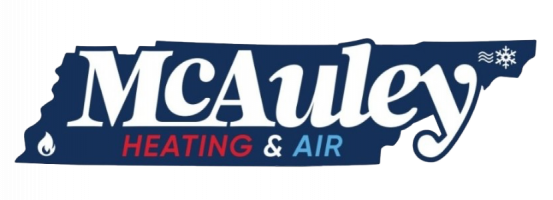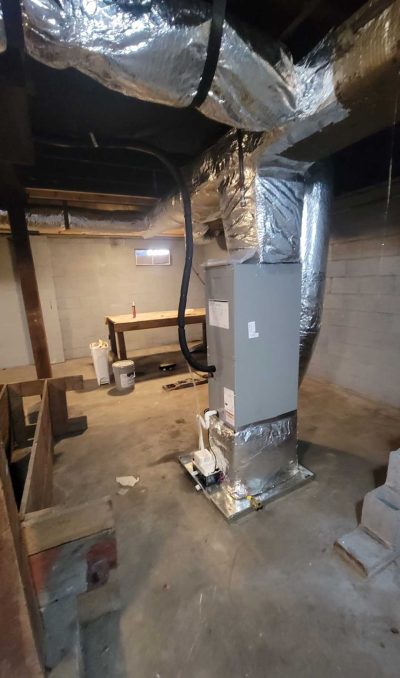How to Prepare Your Heating System for Winter: A Step-by-Step Guide
McAuley Heating and Air
Don't Neglect Your Heater
As winter approaches, ensuring your heating system is ready to handle the colder months is crucial for keeping your home warm, comfortable, and energy-efficient. Regular maintenance and preparation are key to preventing unexpected breakdowns, reducing energy costs, and extending the life of your heating system.
At McAuley Heating and Air, we believe that proper preparation is the best way to avoid costly repairs and maintain optimal performance throughout the winter. In this comprehensive guide, we’ll walk you through essential steps to prepare your heating system for winter, from checking filters to cleaning ducts and scheduling professional maintenance.
Inspect and Replace Air Filters
The first and most important step in preparing your heating system for winter is inspecting and replacing your air filters. Air filters play a critical role in ensuring that the air circulating through your home is clean and free of dust, debris, and allergens. Over time, filters can become clogged with dust and dirt, which restricts airflow and makes your heating system work harder, leading to higher energy bills and potential damage to the unit.
How to Check and Replace Your Filters:
- Locate the Filter: Depending on your system, the filter may be located in the return air vent, near the blower in the furnace, or in the ductwork.
- Inspect the Filter: Hold the filter up to the light. If you can’t see through it, the filter is clogged and needs to be replaced.
- Replace with a New Filter: Replace the old filter with a new one that matches the manufacturer’s specifications. Be sure to check your filter size and type before purchasing a replacement.
Regularly changing your filters (every 1-3 months depending on usage) ensures optimal airflow, improves indoor air quality, and helps prevent strain on your heating system.
*Conditions apply, ask for details.
Clean and Inspect the Ductwork
The ductwork in your home is responsible for distributing warm air throughout the house, so it’s essential to ensure that it is clean and free of obstructions before winter arrives. Over time, dust, debris, and even mold can accumulate in the ducts, reducing airflow and potentially affecting indoor air quality. Leaky ducts can also lead to energy loss and uneven heating in your home.
Steps for Cleaning and Inspecting Your Ducts:
- Visual Inspection: Start by visually inspecting the ducts for signs of dirt, dust, or mold buildup. Look for cracks, holes, or disconnected sections that could be leaking air.
- Cleaning: If you notice dirt or debris, consider vacuuming out the accessible parts of the ducts. For a more thorough cleaning, it’s best to schedule a professional duct cleaning service to ensure your system is free of contaminants.
- Seal Leaks: If you notice any leaks or disconnected sections, seal them with duct tape or consult a professional to fix the issue properly.
Cleaning and inspecting your ducts not only improves airflow and efficiency but also enhances indoor air quality, which is especially important during the winter months when windows are often closed.
Test the Thermostat
Your thermostat is the control center for your heating system, so it’s essential to ensure that it’s functioning properly before the colder months begin. A malfunctioning thermostat can cause your heating system to run inefficiently, leading to higher energy bills and uneven heating throughout your home.
Steps for Testing Your Thermostat:
- Check the Batteries: If your thermostat runs on batteries, replace them to ensure proper operation throughout the winter.
- Test the Settings: Turn on the heating system and adjust the thermostat to a comfortable temperature. Make sure that the system responds by turning on and off as needed.
- Upgrade to a Smart Thermostat: If you’re using an older, manual thermostat, consider upgrading to a programmable or smart thermostat. Smart thermostats allow you to set heating schedules and control your system remotely, optimizing energy use and saving money on heating bills.
Ensuring your thermostat is functioning correctly helps maintain consistent temperatures throughout your home and reduces the strain on your heating system.
Schedule Professional HVAC Maintenance
One of the most important steps in preparing your heating system for winter is scheduling a professional maintenance check. At McAuley Heating and Air, we recommend an annual HVAC maintenance visit to ensure your heating system is running efficiently and safely. A professional technician can identify potential issues before they become major problems, ensuring that your system is ready to handle the demands of winter.
What to Expect During a Professional Maintenance Visit:
- Inspection and Cleaning: The technician will inspect and clean key components of your heating system, including the blower, burners, heat exchanger, and flame sensor. Removing dirt and debris from these components ensures efficient operation and prevents potential malfunctions.
- Safety Checks: The technician will check for safety hazards, such as gas leaks, carbon monoxide leaks, and faulty electrical connections. These checks are crucial for keeping your home safe during the winter months.
- Lubrication and Adjustment: The moving parts of your heating system, such as motors and bearings, will be lubricated to reduce friction and wear. The technician will also make any necessary adjustments to ensure optimal performance.
- Testing: The technician will test the system to ensure it’s operating correctly, including testing thermostat accuracy, airflow, and overall system performance.
Scheduling professional HVAC maintenance before winter ensures your system is running at peak efficiency, reducing the likelihood of unexpected breakdowns and costly repairs.
Inspect the Heat Exchanger
The heat exchanger is a critical component of your furnace or heating system, responsible for transferring heat from the combustion process to the air that circulates through your home. Over time, heat exchangers can develop cracks or corrosion, leading to dangerous carbon monoxide leaks.
How to Inspect the Heat Exchanger:
- Visual Inspection: Look for any visible signs of damage, such as cracks, rust, or corrosion. Be sure to inspect both the exterior and interior of the heat exchanger.
- Professional Inspection: Due to the complexity and importance of the heat exchanger, it’s best to have a professional HVAC technician inspect it during your annual maintenance visit.
A damaged heat exchanger can pose a serious safety risk, so it’s essential to inspect it regularly and replace it if necessary.
Check the Pilot Light or Ignition System
If your heating system uses a pilot light or electronic ignition system, it’s important to ensure that it’s functioning correctly before winter arrives. The pilot light or ignition system is responsible for igniting the burners in your furnace, so any malfunction could prevent your heating system from operating.
How to Check the Pilot Light or Ignition System:
- For Systems with a Pilot Light: Ensure that the pilot light is lit and burning a steady blue flame. If the flame is yellow or flickering, it may indicate a problem with the gas supply or ventilation.
- For Systems with an Electronic Ignition: Test the ignition system by turning on the furnace and observing the ignition sequence. If the system fails to ignite or takes a long time to start, contact a professional for repairs.
Ensuring that your pilot light or ignition system is functioning properly prevents delays in heating and helps avoid potential safety hazards.
Clean Around the Heating Unit
Dust, dirt, and debris can accumulate around your heating unit over time, potentially restricting airflow and causing your system to overheat. Before winter, take the time to clean the area around your furnace or heating unit to ensure proper airflow and prevent fire hazards.
Steps for Cleaning Around Your Heating Unit:
- Clear Debris: Remove any objects or debris around the unit, including dust, dirt, and clutter. Make sure there is at least a three-foot clearance around the unit to allow for proper airflow.
- Vacuum Dust: Use a vacuum cleaner to remove dust from the exterior of the unit, as well as from vents, grilles, and registers.
Keeping the area around your heating system clean helps ensure proper airflow and reduces the risk of overheating or fire.
Inspect and Clean Vents and Registers
Blocked or dirty vents and registers can restrict airflow and reduce the efficiency of your heating system. Before winter, inspect all vents and registers in your home to ensure they are clean and free of obstructions.
Steps for Cleaning Vents and Registers:
- Remove Dust: Use a vacuum cleaner or a microfiber cloth to remove dust and debris from the vents and registers. Make sure to clean both the vent covers and the duct openings.
- Ensure Unobstructed Airflow: Ensure that furniture, rugs, or curtains are not blocking the vents and registers. Proper airflow is essential for efficient heating and maintaining even temperatures throughout your home.
Clean vents and registers help improve indoor air quality and ensure your heating system operates efficiently.
Test the Carbon Monoxide Detectors
Carbon monoxide is an odorless, colorless gas that can be produced by malfunctioning heating systems, especially gas furnaces. To ensure your home is safe during the winter, it’s essential to test your carbon monoxide detectors regularly.
How to Test Carbon Monoxide Detectors:
- Check the Batteries: Replace the batteries in your carbon monoxide detectors to ensure they are fully charged and ready to operate.
- Test the Alarms: Press the test button on each detector to ensure that the alarm sounds. If the alarm doesn’t sound, replace the detector or contact a professional for repairs.
- Replace Old Detectors: If your carbon monoxide detectors are more than five years old, consider replacing them with newer models.
Testing your carbon monoxide detectors ensures that your home is protected from potential gas leaks and dangerous emissions during the winter months.
Winter is Coming
Preparing your heating system for winter is essential for maintaining a comfortable, efficient, and safe home. By following these steps—inspecting and replacing filters, cleaning ducts, testing your thermostat, scheduling professional maintenance, and checking key components—you can ensure your heating system is ready to handle the demands of the colder months. At McAuley Heating and Air, we offer comprehensive HVAC maintenance services to help you prepare your system for winter and ensure it operates efficiently all season long.
Contact us today to schedule your maintenance appointment and enjoy a warm, worry-free winter!




